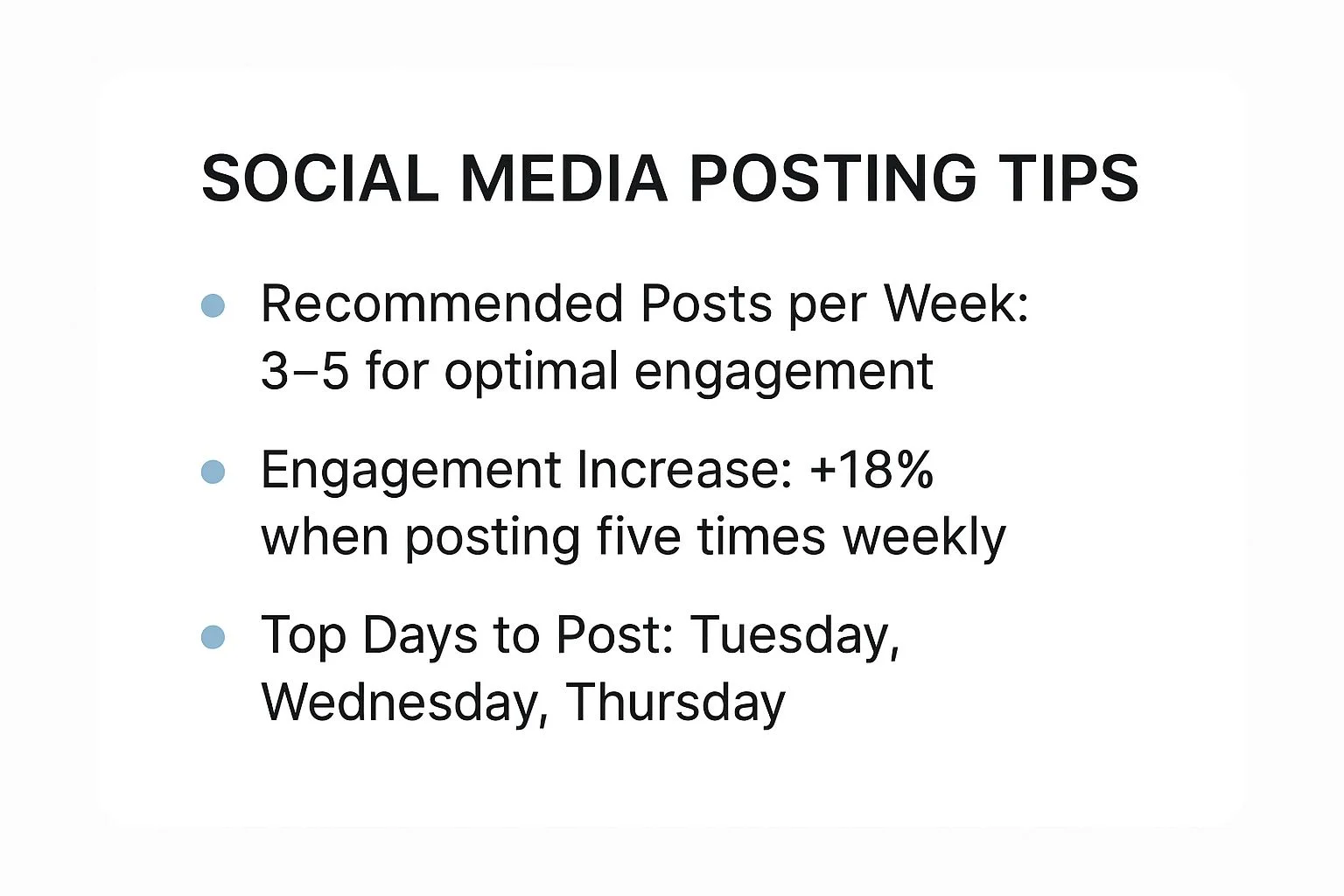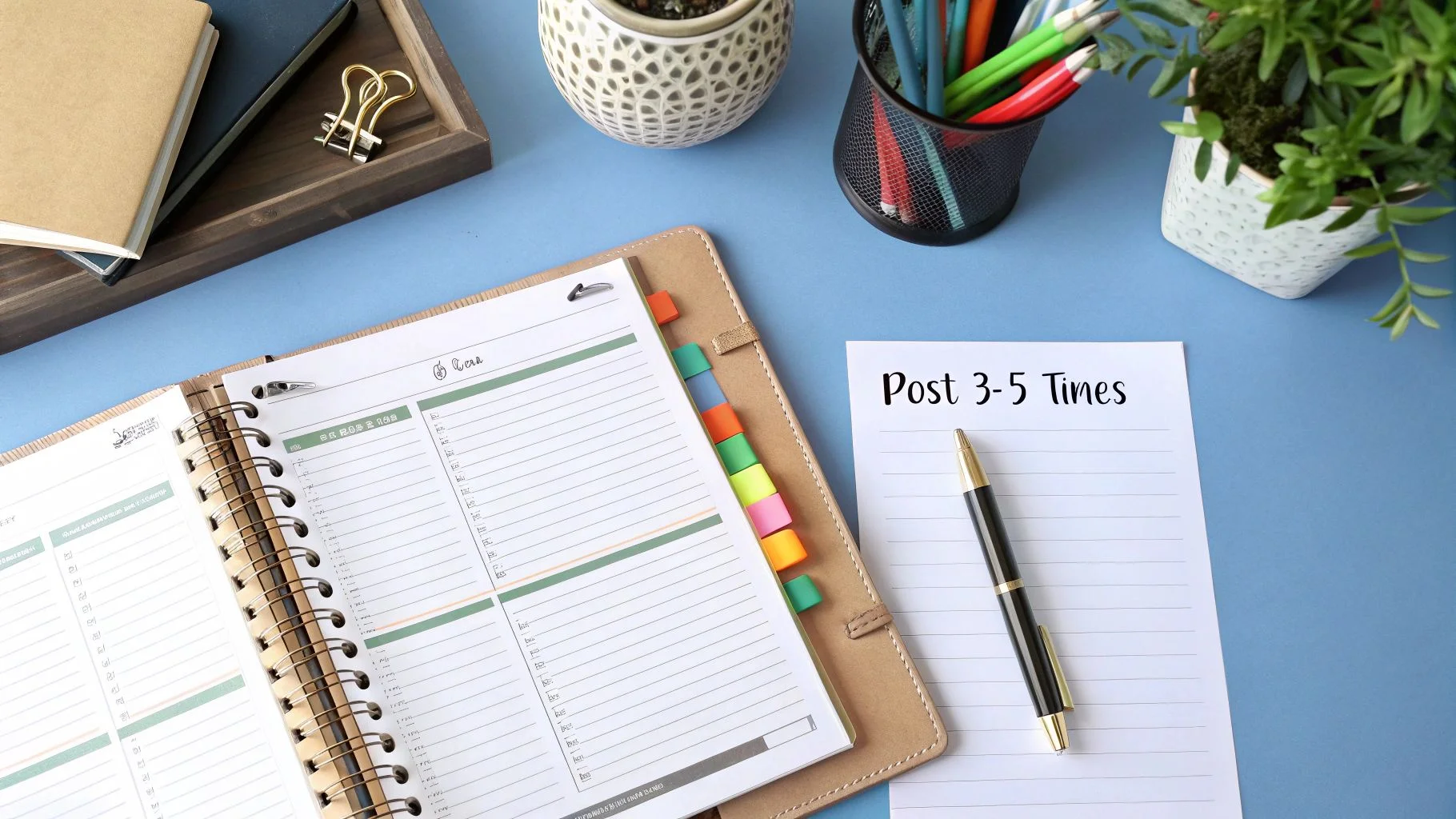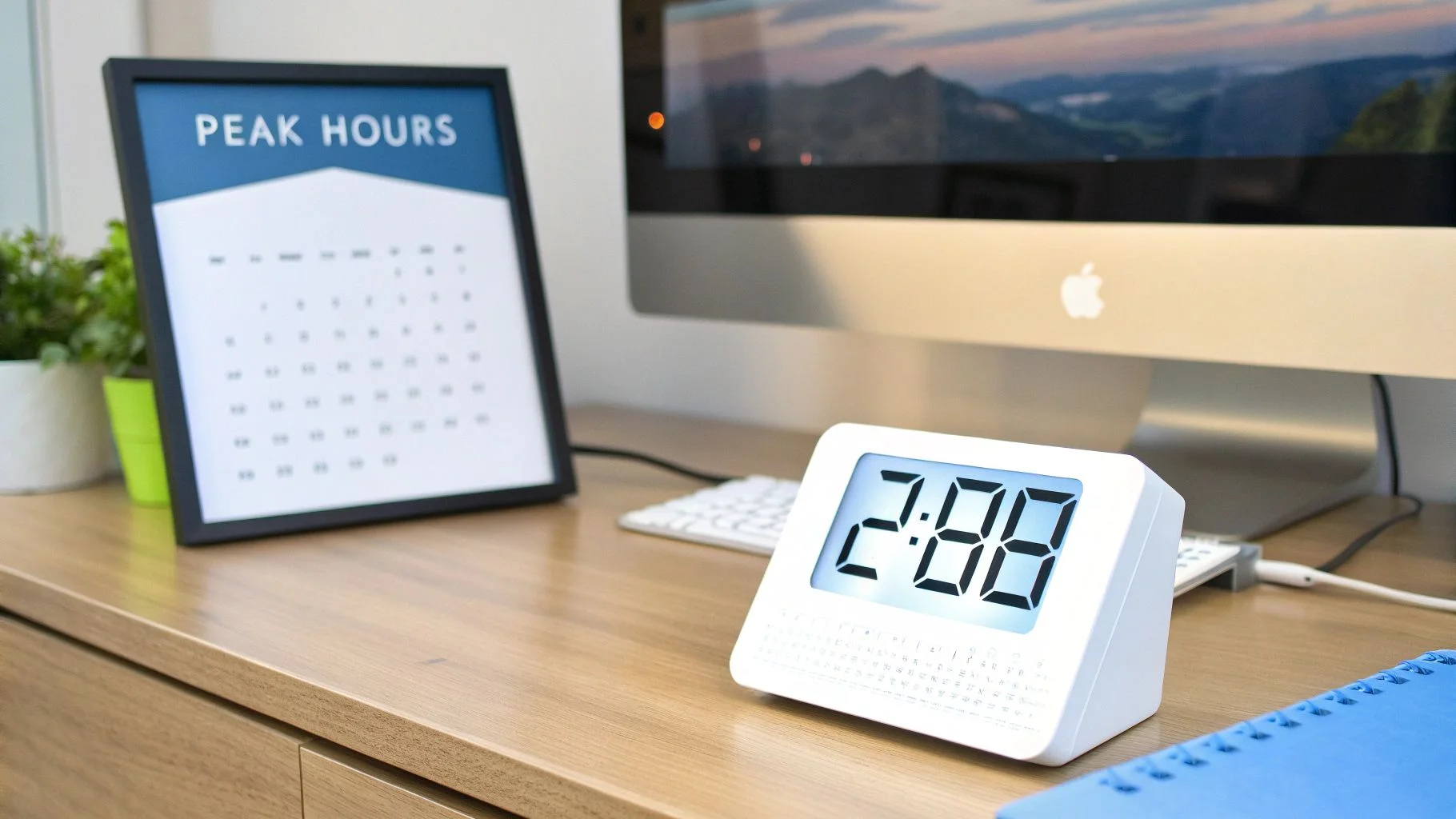How Often Should You Post on LinkedIn? Maximize Engagement
Find the perfect LinkedIn posting frequency. Learn how often to post for maximum visibility and engagement without overwhelming your audience.

How Often Should You Post on LinkedIn? Maximize Engagement
Alright, let's get straight to it. People always ask for the magic number, so here it is: for most of us, the sweet spot for posting on LinkedIn is somewhere between 2 to 5 times per week.
This isn't just a random number. It's a rhythm that keeps you consistently visible in your network's feed without turning into background noise. Think of it as the perfect starting point—a solid balance between staying top-of-mind and actually respecting your audience's time.
Finding Your LinkedIn Posting Frequency
Figuring out how often to post isn't about finding one single, perfect number. It’s about understanding the delicate dance between visibility, effort, and how your audience responds.
Imagine you're tending to a plant. If you don't water it enough, it withers. If you water it too much, you'll drown it. Your goal is to find that perfect cadence that encourages steady, healthy growth.
This infographic lays it all out visually, highlighting the key data points to help you find that rhythm.

As you can see, the data doesn't lie. Focusing your efforts mid-week and aiming for that three-to-five post range tends to deliver the biggest bang for your buck.
Breaking Down Different Frequencies
To help you find your groove, let's look at what different posting volumes actually mean in practice. Remember, posting more isn't always better, especially if the quality of your content starts to slide.
1 Post Per Week: This is the bare minimum. You’re essentially just keeping the lights on. It shows your profile isn't abandoned, but it’s not going to build any real momentum or grow your audience.
2-5 Posts Per Week: This is the goldilocks zone for most people aiming for sustainable growth. It consistently signals to the LinkedIn algorithm that you're an active contributor, which often gets your posts more reach.
6+ Posts Per Week: This is the high-octane approach. It can accelerate your growth, but only if you have the firepower to maintain high-quality, valuable content. This pace demands a serious content machine to avoid burnout and annoying your followers.
The best LinkedIn strategy is the one you can actually stick with. Being consistent at a lower frequency will always beat random, high-volume bursts of activity. Start with what feels manageable and build from there.
To make this even clearer, here's a quick table that sums up what to expect at each level. It’s designed to help you match your posting frequency with your goals and, just as importantly, your capacity.
LinkedIn Posting Frequency at a Glance
| Posting Frequency (Per Week) | Impact on Visibility and Engagement | Best For |
|---|---|---|
| 1 Post | Maintenance Mode. Keeps your profile active but expect minimal growth and low engagement. | Professionals with extremely limited time or those just starting to build a posting habit. |
| 2-5 Posts | The Growth Zone. Ideal for building momentum, staying visible, and signaling consistency to the algorithm. | Most professionals, executives, and brands focused on steady, long-term growth. |
| 6+ Posts | High-Volume Strategy. Can lead to rapid growth but risks audience fatigue and requires a strong content pipeline. | Content creators, dedicated brand influencers, and companies with a full-time content team. |
Ultimately, this table should give you a solid baseline. Pick the lane that feels right for you, start there, and get ready to test and adjust as you go.
How the LinkedIn Algorithm Sees Your Posts

To figure out how often you should be posting, you first need to get inside the head of the LinkedIn algorithm. Think of it as a super-smart curator for every user's feed. Its one and only job is to show people the most relevant, interesting stuff possible.
So when you hit "publish," you're not just broadcasting to your network. You're actually handing your post over to this curator for a quick look. The algorithm immediately starts a small test, showing it to a handful of your connections to see if it's any good.
This is where the game is won or lost. The algorithm is watching for all the right signs.
The Critical First Hour
Those first 60 minutes after you post are what many call the "golden hour." This is your window of opportunity.
Early likes, comments, and shares are like ringing a bell. Each one sends a tiny signal to the algorithm that says, "Hey, people are actually into this!"
If your post gets a nice burst of engagement right out of the gate, the algorithm thinks, "Okay, this has potential." As a reward, it'll start showing your content to more of your network, and maybe even to people you don't know (second and third-degree connections). That's how things start to take off.
But if it's crickets? If nobody bites in that first hour? The algorithm just assumes it's a dud and quietly stops showing it to people. It's a simple feedback loop, and it’s why a steady posting rhythm matters so much. You're training both your audience and the algorithm to pay attention when you speak.
Your goal isn't just to throw content at the algorithm. It's to consistently give it positive signals, teaching it to prioritize your posts every time.
Why Consistency Is Your Secret Weapon
Posting randomly is like flaking on a friend. It tells the algorithm you're not a reliable source of good content. The algorithm loves consistency because it shows you're a committed member of the community, regularly adding value.
When you post on a regular schedule, you create a pattern it can trust. Here's what that steady rhythm does for you:
Builds Audience Habits: Your followers start to expect—and even look for—your posts.
Signals Reliability: The algorithm learns that you're an active, dependable contributor.
Creates Momentum: Every post that does well gives the next one a little boost, creating a snowball effect over time.
This is why switching from a "post when I feel like it" approach to a steady schedule is a total game-changer. The data shows that posting a consistent 2–5 times per week is the sweet spot for building real momentum.
As you start to understand the difference between followers vs connections, you'll see how this reliable presence helps you attract the right kind of audience—the ones who will actually engage. If you really want to put your foot on the gas, cranking that up to 6 to 10 posts per week can seriously amplify your reach and engagement.
Finding the Right Cadence for Your Industry

It’s tempting to search for a single "magic number" for how often you should post on LinkedIn. But it's a myth. The truth is, every industry has its own rhythm and its own audience expectations.
What works for a fast-paced tech startup will almost certainly overwhelm the network of, say, a financial services professional. You have to match the vibe of your professional world.
Match Your Frequency to the Professional Culture
Think of it like different kinds of conversations. A marketing conference is a constant buzz of rapid-fire ideas and non-stop updates. A medical symposium, on the other hand, moves at a much more deliberate pace, with every point backed by deep research.
Your LinkedIn frequency needs to mirror that conversational speed.
Are your people looking for daily hot takes on the latest trends? Or do they prefer one or two deeply insightful analyses a week? Getting this right is how you deliver value that actually resonates instead of just adding to the noise.
For instance, a social media marketer might post every single day to stay on top of new platform features and campaign results. Their audience expects it. But a healthcare consultant will likely see more success with just two well-researched posts a week breaking down complex regulations.
The goal isn’t to follow some generic rulebook. It's to sync up with the communication norms your industry already follows. Quality and relevance always beat sheer volume.
Industry-Specific Posting Benchmarks
While you’ll ultimately need to test and see what works for you, there are some solid benchmarks that give you a great place to start.
Different sectors have totally different engagement patterns, which means you need to adjust how often you share to stay visible without annoying your followers.
Technology & Marketing: These fields move fast. Think 4–5 posts per week just to keep up with the crowded, fast-paced feed.
Healthcare & Academia: Here, depth trumps frequency. You're better off with 2–3 weekly posts that are detailed and packed with value.
Financial Services: This industry strikes a nice balance. Aim for 3–4 posts weekly, mixing market news with evergreen educational insights.
Of course, how often you post is only half the battle. When you post is just as critical.
To make sure your carefully crafted posts actually get seen, check out our guide on the best times to post on social media. Pairing the right frequency with the right timing is what turns a good content plan into a great one.
How Posting Volume Impacts Your Visibility

It’s one thing to talk theory about algorithms and consistency, but what do the hard numbers actually say? It turns out that posting more often has a direct, measurable impact on your post impressions.
But it's not just about blasting content into the void. Understanding how this works is the key to building a strategy that doesn't just make noise but actually gets results.
The Data Behind Posting More Often
A recent deep dive into over two million LinkedIn posts uncovered a crystal-clear link between posting volume and impressions. This isn't just a hunch; it's a pattern backed by a massive amount of data.
The findings show that with every step up in your posting frequency, you get a stronger push from the platform.
For example, just moving from once a week to 2 to 5 times per week adds an average of about 1,000 more impressions to each post. That's the first big jump where you can see the algorithm starting to pay attention.
But when you ramp things up even more, the rewards get seriously impressive.
6 to 10 posts per week: This level brings a huge bump, averaging around 5,000 additional impressions per post.
11+ posts per week: The most active creators? They can pull in a staggering 16,000 more impressions for every single update.
This data confirms it: the more consistently you show up with good content, the more LinkedIn rewards you with a bigger spotlight.
Finding Your Point of Maximum Impact
While the numbers scream "more is better," there's a catch: impression fatigue. This is the tipping point where your audience, even if they like your stuff, starts to tune you out simply because they’re seeing you too often.
Your real goal is to find that sweet spot where volume and quality intersect. Posting more only works if you can keep the quality high. If your standards drop, your engagement will tank, and the algorithm will shove your posts to the back of the line.
Don’t chase a high post count at the expense of value. A smaller number of high-engagement posts will always outperform a large volume of mediocre content that gets ignored.
Think of it as a strategic investment. Every single post needs a purpose—to inform, engage, or inspire. To nail this, you have to know how to improve your reach for LinkedIn posts by creating content that stops the scroll and starts conversations.
After all, turning passive views into meaningful engagement is the name of the game.
Building a Content Plan That Doesn't Lead to Burnout
Knowing you need to post 2-5 times a week is one thing. Actually doing it without losing your mind is another. The real challenge isn't just showing up; it's building a system that makes showing up feel easy.
Forget the daily "what do I post?" panic. The secret is to stop thinking post-by-post and start thinking in batches. Carve out one block of time to create a full week's worth of content. This flips content creation from a nagging daily chore into a scheduled, manageable task.
Streamline Your Ideas with Content Pillars
To make batching work, you need a well of ideas you can always draw from. That's where content pillars come in. Think of these as the 3-5 core topics you want to be known for—the central themes of your brand.
For instance, a marketing leader might build their presence around:
Team Leadership: Sharing real-world stories about managing creative teams.
Brand Strategy: Deconstructing what makes a great campaign tick.
Marketing Tech: Talking about new tools and whether they’re actually useful.
Career Growth: Giving advice to marketers trying to climb the ladder.
Pillars are your compass. When you’re stuck for an idea, you just turn to one of your topics. It kills the guesswork and ensures every single post reinforces your expertise, building a brand that people remember.
Work Smarter, Not Harder: The Art of Repurposing
You don't have to reinvent the wheel for every post. The most efficient creators are masters of content repurposing—taking one big idea and slicing it into multiple smaller pieces.
It’s all about getting the most mileage out of your best work. A single piece of "pillar content" can easily fuel your LinkedIn feed for a week or more.
Think of your content like a Thanksgiving turkey. You have the big meal on Thursday. But then you’ve got leftovers for sandwiches, soup, and tacos for days. One big effort, multiple meals.
Here’s how you could spin a single 30-minute webinar into five different posts:
The Main Event: Share the link to the full webinar recording with a quick summary of the best parts.
The Quote Graphic: Pull one killer quote from the talk and drop it onto a simple background.
The Video Clip: Snip a 60-second highlight that explains one powerful idea.
The Deep Dive: Write a text-only post expanding on a great question someone asked in the Q&A.
The Conversation Starter: Run a poll related to the webinar's main topic to get your audience talking.
A system like this means you always have something valuable ready to go. Combine your pillars with smart repurposing, and you’ll hit your ideal posting frequency without the daily grind.
Testing and Refining Your Posting Schedule
So, you've got the benchmarks and the best practices. But here's the thing: your LinkedIn strategy isn't a "set it and forget it" kind of deal.
Think of it as a living plan that needs to adapt. The advice I've shared is your starting line, not the finish line. Now it’s time to put on your lab coat and become a scientist in your own content lab.
This doesn't mean you need a degree in data science or a bunch of expensive tools. It's really just about making small, smart tweaks and seeing what happens. The goal is to run simple, controlled experiments to figure out what your network actually wants to see from you.
A Simple Framework for Experimenting
To nail down how often you should be posting, you need a clear, simple test. We want to isolate one variable—frequency—so you can see its direct impact.
Here’s a straightforward A/B test you can run over the next two months:
Month 1 (Your Control): Stick to a baseline of three high-quality posts per week. Try to post on the same days and at similar times to keep things consistent.
Month 2 (Your Test): Amp it up to five high-quality posts per week. Again, keep your posting times and the quality of your content as consistent as you can.
At the end of each month, you’ll sit down and compare the data. This simple experiment will give you a surprisingly clear answer on whether the extra effort of posting more is actually paying off.
Your LinkedIn Analytics is the ultimate source of truth. General advice is helpful, but your own data is what will truly move the needle. Pay close attention to what it's telling you.
Key Metrics to Actually Watch
When you dive into your analytics, it’s easy to get distracted by vanity metrics. Instead, laser-focus on the numbers that signal a real connection with your audience and have a tangible business impact.
Here's what to look for:
Impressions Per Post: Did the average reach of your posts go up or down when you started posting more often?
Engagement Rate: Calculate this yourself: (Likes + Comments + Reposts) ÷ Impressions. Did a higher frequency lead to better (or worse) engagement on each post?
Follower Growth: Did you gain followers at a faster rate during your higher-volume month?
Profile Views: Are more people getting curious and clicking through to your profile because of your increased activity?
Let the numbers do the talking. Tracking these key indicators will help you find a sustainable rhythm that gets you the most visibility and impact without burning you out.
A Few Lingering Questions
Even with the best game plan, some specific questions always pop up once you start finding your groove. Let's tackle the most common ones.
Is Posting on LinkedIn Every Single Day a Bad Idea?
Not necessarily, but it's a classic high-risk, high-reward play. It really only pays off if you can deliver absolute top-tier quality with every single post, every single day.
If your daily updates start feeling repetitive or a bit thin, you're going to see audience fatigue kick in fast, and your engagement will drop. For almost everyone, three to five genuinely valuable posts a week will crush seven mediocre ones.
Think of it this way: your goal is to become a voice people want to hear from, not just a name they see all the time. Quality over a daily quota, always.
Okay, So What’s the Real Best Time to Post?
You'll see all sorts of advice pointing to mid-week during business hours, but the truth is, the only "best time" is when your specific audience is actually online and scrolling.
Your own LinkedIn Analytics is the only source of truth here. Dive into the data and see when your followers are most active. Then, start testing different time slots—think early mornings before the workday kicks off, lunchtime, or even during the evening commute. Let your own data be your guide.
Will Reposting Old Content Tank My Reach?
This can be a really smart move to get more mileage out of your greatest hits, but you can't just hit the share button and call it a day. The algorithm won't be impressed.
Instead, create a brand new post that references the old one. Add a fresh take, pull out a different lesson, or ask a new question. This frames it as new content and gives both the algorithm and your audience a reason to pay attention. Just avoid reposting the exact same thing within a few weeks.
Ready to make your LinkedIn engagement consistent and effortless? Social Presence is a lightweight Chrome extension that helps you show up, cut through the noise, and build meaningful connections faster. Try Social Presence for free.
Article created using Outrank